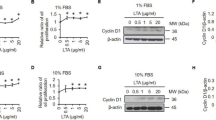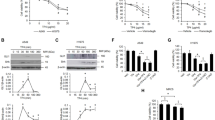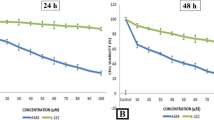Abstract
Lung cancer is the leading cause of cancer deaths globally with most of the reported cases (> 85%) associated with non-small cell lung cancer (NSCLC). Current therapies have enhanced the overall survival rate of patients but treatment-related adverse effects and increase in drug-resistance limit the success of these treatment options. Antimicrobial peptides (AMPs) have gained interest as anticancer agents as they selectively target cancer cells and decrease the possibility of resistance. Nisin ZP is a polycyclic antimicrobial peptide produced by the Gram-positive bacterium, Lactococcus lactis and is commonly used as a food preservative. Nisin ZP has recently demonstrated anticancer activity in melanoma, head and neck squamous cell carcinoma, hepatic, colon, and blood cancer. In this study, we evaluated the anticancer potential of nisin ZP and assessed the underlying mechanisms in NSCLC cells. The results revealed that nisin ZP induced selective toxicity in cancer (A549 and H1299) cells compared to healthy (HEK293) cells after 48 h of treatment. Nisin ZP exposure induced apoptosis and cell cycle arrest (G0/G1 phase) in NSCLC cells irrespective of tumor protein p53 expression. The cancer cell proliferation was inhibited via non-membranolytic pathways by mitochondrial membrane depolarization and elevation in reactive oxygen species (ROS) generation. Furthermore, nisin ZP decreased cancer cells’ clonal expansion and migration, demonstrating potential use against highly metastatic NSCLC. The 3D spheroid growth and cell viability of the A549 cells were significantly inhibited by nisin ZP compared to control. Overall, the results suggest an excellent antitumor potential in vitro and, thus, can further be developed as a novel therapeutic for NSCLC.








Similar content being viewed by others
References
Sung H, Ferlay J, Siegel RL, Laversanne M, Soerjomataram I, Jemal A, et al. Global Cancer Statistics 2020: GLOBOCAN Estimates of Incidence and Mortality Worldwide for 36 Cancers in 185 Countries. CA Cancer J Clin. 2021;71:209–49.
Lu T, Yang X, Huang Y, Zhao M, Li M, Ma K, et al. Trends in the incidence, treatment, and survival of patients with lung cancer in the last four decades. Cancer Manag Res. 2019;11:943–53.
Lemjabbar-Alaoui H, Hassan O, Yang Y-W, Buchanan P. Lung cancer: biology and treatment options. Biochim Biophys Acta. 2015;1856:189–210.
Howlader N, Forjaz G, Mooradian MJ, Meza R, Kong CY, Cronin KA, et al. The Effect of Advances in Lung-Cancer Treatment on Population Mortality. N Engl J Med. 2020;383:640–9.
Pucci C, Martinelli C, Ciofani G. Innovative approaches for cancer treatment: current perspectives and new challenges. Ecancermedicalscience. 2019;13 961:1–26.
Gao Y, Shang Q, Li W, Guo W, Stojadinovic A, Mannion C, et al. Antibiotics for cancer treatment: A double-edged sword. J Cancer. 2020;11:5135–49.
Zandsalimi F, Talaei S, Noormohammad Ahari M, Aghamiri S, Raee P, Roshanzamiri S, et al. Antimicrobial peptides: a promising strategy for lung cancer drug discovery? Expert Opin Drug Discov. 2020;15:1343–54.
Kunda NK. Antimicrobial peptides as novel therapeutics for non-small cell lung cancer. Drug Discovery Today. 2020;25:238–47.
Xie M, Liu D, Yang Y. Anti-cancer peptides: classification, mechanism of action, reconstruction and modification. Open Biol. 2020;10:200004:1–10.
Gaspar D, Veiga AS, Castanho MARB. From antimicrobial to anticancer peptides. A review. Front Microbiol. 2013;4:294:1–16.
Kaur S, Kaur S. Bacteriocins as Potential Anticancer Agents. Front Pharmacol. 2015;6:272:1–11.
Benmechernene Z, Fernandez-No I, Kihal M, Böhme K, Calo-Mata P, Barros-Velazquez J. Recent patents on bacteriocins: food and biomedical applications. Recent Pat DNA Gene Seq. 2013;7:66–73.
Shin JM, Gwak JW, Kamarajan P, Fenno JC, Rickard AH, Kapila YL. Biomedical Applications of Nisin. J Appl Microbiol. 2016;120:1449–65.
Zainodini N, Hassanshahi G, Hajizadeh M, Falahati-Pour SK, Mahmoodi M, Mirzaei MR. Nisin Induces Cytotoxicity and Apoptosis in Human Asterocytoma Cell Line (SW1088). Asian Pac J Cancer Prev. 2018;19:2217–22.
Zainodini N, Hajizadeh MR, Mirzaei MR. Evaluation of Apoptotic Gene Expression in Hepatoma Cell Line (HepG2) Following Nisin Treatment. Asian Pac J Cancer Prev. 2021;22:1413–9.
Avand A, Akbari V, Shafizadegan S. In Vitro Cytotoxic Activity of a Lactococcus lactis Antimicrobial Peptide Against Breast Cancer Cells. Iran J Biotechnol. 2018;16:213–20.
Ahmadi S, Ghollasi M, Hosseini HM. The apoptotic impact of nisin as a potent bacteriocin on the colon cancer cells. Microb Pathog. 2017;111:193–7.
Wiedemann I, Breukink E, van Kraaij C, Kuipers OP, Bierbaum G, de Kruijff B, et al. Specific binding of nisin to the peptidoglycan precursor lipid II combines pore formation and inhibition of cell wall biosynthesis for potent antibiotic activity. J Biol Chem. 2001;276:1772–9.
Joo NE, Ritchie K, Kamarajan P, Miao D, Kapila YL. Nisin, an apoptogenic bacteriocin and food preservative, attenuates HNSCC tumorigenesis via CHAC1. Cancer Med. 2012;1:295–305.
Kamarajan P, Hayami T, Matte B, Liu Y, Danciu T et al (2015) Nisin ZP, a bacteriocin and food preservative, inhibits head and neck cancer tumorigenesis and prolongs survival. PLOS ONE 10(7):e0131008. https://doi.org/10.1371/journal.pone.0131008
Lewies A, Wentzel JF, Miller HC, Du Plessis LH. The antimicrobial peptide nisin Z induces selective toxicity and apoptotic cell death in cultured melanoma cells. Biochimie. 2018;144:28–40.
Goudarzi F, Asadi A, Afsharpour M, Jamadi RH. In Vitro Characterization and Evaluation of the Cytotoxicity Effects of Nisin and Nisin-Loaded PLA-PEG-PLA Nanoparticles on Gastrointestinal (AGS and KYSE-30), Hepatic (HepG2) and Blood (K562) Cancer Cell Lines. AAPS PharmSciTech. 2018;19:1554–66.
Kunda NK, Alfagih IM, Miyaji EN, Figueiredo DB, Gonçalves VM, Ferreira DM, et al. Pulmonary dry powder vaccine of pneumococcal antigen loaded nanoparticles. Int J Pharm. 2015;495:903–12.
Patil SM, Sawant SS, Kunda NK. Inhalable bedaquiline-loaded cubosomes for the treatment of non-small cell lung cancer (NSCLC). International Journal of Pharmaceutics. 2021;607:121046:1–11.
Muse® Annexin V & Dead Cell Kit [Internet]. [cited 2021 Aug 15]. Available from: https://www.luminexcorp.com/muse-annexin-v-dead-cell-kit/#documentation. Accessed 2 Mar 2022
Muse® Cell Cycle Kit [Internet]. [cited 2021 Aug 15]. Available from: https://www.luminexcorp.com/muse-cell-cycle-kit/. Accessed 2 Mar 2022
Sawant SS, Patil SM, Shukla SK et al (2021) Pulmonary delivery of osimertinib liposomes for non-small cell lung cancer treatment: formulation development and in vitro evaluation. Drug Deliv and Transl Res. https://doi.org/10.1007/s13346-021-01088-0
Wu X-X, Yue GG-L, Dong J-R, Lam CW-K, Wong C-K, Qiu M-H, et al. Actein Inhibits the Proliferation and Adhesion of Human Breast Cancer Cells and Suppresses Migration in vivo. Front Pharmacol. 2018;9:1466.
Zhang X, Lin D, Jiang R, Li H, Wan J, Li H. Ferulic acid exerts antitumor activity and inhibits metastasis in breast cancer cells by regulating epithelial to mesenchymal transition. Oncology Reports Spandidos Publications. 2016;36:271–8.
Shukla SK, Kulkarni NS, Farrales P, Kanabar DD, Parvathaneni V, Kunda NK, et al. Sorafenib Loaded Inhalable Polymeric Nanocarriers against Non-Small Cell Lung Cancer. Pharm Res. 2020;37:67:1–19.
Maj E, Trynda J, Maj B, Gębura K, Bogunia-Kubik K, Chodyński M, et al. Differential response of lung cancer cell lines to vitamin D derivatives depending on EGFR, KRAS, p53 mutation status and VDR polymorphism. The Journal of Steroid Biochemistry and Molecular Biology. 2019;193:105431.
Khamchun S, Thongboonkerd V. Cell cycle shift from G0/G1 to S and G2/M phases is responsible for increased adhesion of calcium oxalate crystals on repairing renal tubular cells at injured site. Cell Death Discovery. 2018;4:1–12.
Zhu M, Miao S, Zhou W, Elnesr SS, Dong X, Zou X. MAPK, AKT/FoxO3a and mTOR pathways are involved in cadmium regulating the cell cycle, proliferation and apoptosis of chicken follicular granulosa cells. Ecotoxicol Environ Saf. 2021;214:112091:1–11.
Roudi R, Syn NL, Roudbary M. Antimicrobial Peptides As Biologic and Immunotherapeutic Agents against Cancer: A Comprehensive Overview. Frontiers in Immunology. 2017;8:1320:1–10.
Lu Y, Zhang T-F, Shi Y, Zhou H-W, Chen Q, Wei B-Y, et al. PFR peptide, one of the antimicrobial peptides identified from the derivatives of lactoferrin, induces necrosis in leukemia cells. Sci Rep. 2016;6:20823:1–12.
Kuroda K, Fukuda T, Okumura K, Yoneyama H, Isogai H, Savage PB, et al. Ceragenin CSA-13 induces cell cycle arrest and antiproliferative effects in wild-type and p53 null mutant HCT116 colon cancer cells. Anticancer Drugs. 2013;24:826–34.
Guntur VP, Waldrep JC, Guo JJ, Selting K, Dhand R. Increasing P53 Protein Sensitizes Non-Small Cell Lung Cancer to Paclitaxel and Cisplatin In Vitro. Anticancer Research. International Institute of Anticancer Research. 2010;30:3557–64.
Rohr U-P, Wulf M-A, Stahn S, Heyd F, Steidl U, Fenk R, et al. Non-small lung cancer cells are prime targets for p53 gene transfer mediated by a recombinant adeno-associated virus type-2 vector. Cancer Gene Ther Nature Publishing Group. 2003;10:898–906.
Mitsudomi T, Hamajima N, Ogawa M, Takahashi T. Prognostic Significance of p53 Alterations in Patients with Non-Small Cell Lung Cancer: A Meta-Analysis. Clin Cancer Res. American Association for Cancer Research. 2000;6:4055–63.
Fujita T, Kiyama M, Tomizawa Y, Kohno T, Yokota J. Comprehensive analysis of p53 gene mutation characteristics in lung carcinoma with special reference to histological subtypes. International Journal of Oncology Spandidos Publications. 1999;15:927–61.
Gao Z, Kang X, Hu J, Ju Y, Xu C. Induction of apoptosis with mitochondrial membrane depolarization by a glycyrrhetinic acid derivative in human leukemia K562 cells. Cytotechnology. 2012;64:421–8.
Zhao R-Z, Jiang S, Zhang L, Yu Z-B. Mitochondrial electron transport chain, ROS generation and uncoupling (Review). International Journal of Molecular Medicine. Spandidos Publications. 2019;44:3–15.
Zaidieh T, Smith JR, Ball KE, An Q. ROS as a novel indicator to predict anticancer drug efficacy. BMC Cancer. 2019;19:1224:1–14.
Su B-C, Pan C-Y, Chen J-Y. Antimicrobial Peptide TP4 Induces ROS-Mediated Necrosis by Triggering Mitochondrial Dysfunction in Wild-Type and Mutant p53 Glioblastoma Cells. Cancers (Basel). 2019;11:171:1–18.
Yang T, Li J, Jia Q, Zhan S, Zhang Q, Wang Y, et al. Antimicrobial peptide 17BIPHE2 inhibits the proliferation of lung cancer cells in vitro and in vivo by regulating the ERK signaling pathway. Oncology Letters Spandidos Publications. 2021;22:1–15.
Liu X, Li J, Huang L, Yang J, Wang Y, Yang M, et al. Preparation and Evaluation of MPEG-PCL Polymeric Nanoparticles Against Gastric Cancer. J Wuhan Univ Technol-Mat Sci Edit. 2020;35:1162–8.
Tian W, Li B, Zhang X, Dang W, Wang X, Tang H, et al. Suppression of tumor invasion and migration in breast cancer cells following delivery of siRNA against Stat3 with the antimicrobial peptide PR39. Oncol Rep. 2012;28:1362–8.
Costa EC, Moreira AF, de Melo-Diogo D, Gaspar VM, Carvalho MP, Correia IJ. 3D tumor spheroids: an overview on the tools and techniques used for their analysis. Biotechnol Adv. 2016;34:1427–41.
Nunes AS, Barros AS, Costa EC, Moreira AF, Correia IJ. 3D tumor spheroids as in vitro models to mimic in vivo human solid tumors resistance to therapeutic drugs. Biotechnol Bioeng. 2019;116:206–26.
Raileanu M, Popescu A, Bacalum M. Antimicrobial Peptides as New Combination Agents in Cancer Therapeutics: A Promising Protocol against HT-29 Tumoral Spheroids. Int J Mol Sci. 2020;21:6964:1–13.
Felício MR, Silva ON, Gonçalves S, Santos NC, Franco OL. Peptides with Dual Antimicrobial and Anticancer Activities. Front Chem. 2017;5:5:1–19.
Acknowledgements
This study was supported by funds provided to NKK by the Office of Grants and Sponsored Research, St. John’s University and New Investigator Award, American Association of Colleges of Pharmacy (AACP). In addition, SMP was supported by teaching assistantship from the Department of Pharmaceutical Sciences, College of Pharmacy and Health Sciences (CPHS), St. John’s University. All authors declare no conflict of interest in this work.
Author information
Authors and Affiliations
Corresponding author
Additional information
Publisher's Note
Springer Nature remains neutral with regard to jurisdictional claims in published maps and institutional affiliations.
Rights and permissions
About this article
Cite this article
Patil, S.M., Kunda, N.K. Nisin ZP, an Antimicrobial Peptide, Induces Cell Death and Inhibits Non-Small Cell Lung Cancer (NSCLC) Progression in vitro in 2D and 3D Cell Culture. Pharm Res 39, 2859–2870 (2022). https://doi.org/10.1007/s11095-022-03220-2
Received:
Accepted:
Published:
Issue Date:
DOI: https://doi.org/10.1007/s11095-022-03220-2




